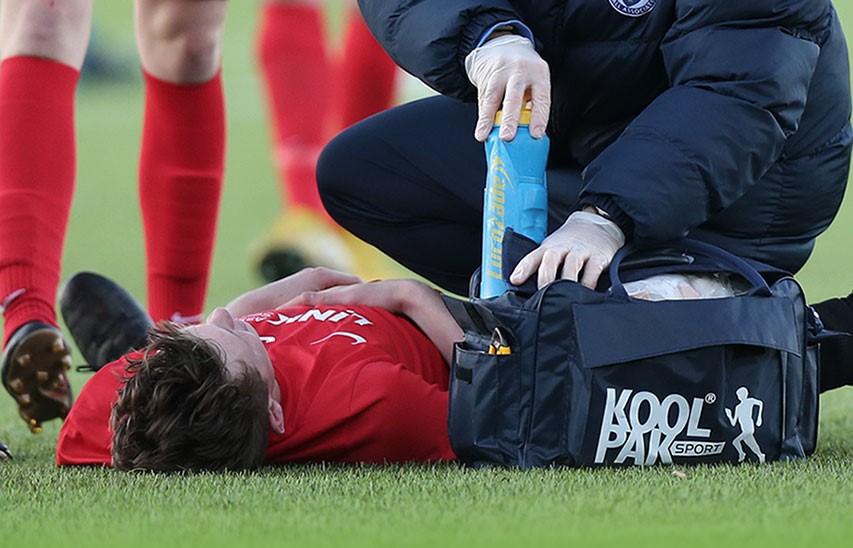A Comprehensive Guide to Health and Safety for Grassroots Football Clubs

There’s a feeling among many players, coaches and administrators that health and safety within grassroots football is an administrative, box-ticking exercise. While there’s an element of truth in this point of view, the principles of health and safety are, first and foremost, about protecting people from accidents, mishaps, and bad behaviour.
Of course, you can never eliminate risk from any endeavour — whether you’re hosting a Sunday league football match or just walking down the street. But by taking the issue of health and safety seriously, you can make everyone involved just that little bit safer.
Here are the steps you should take to ensure health and safety within your grassroots football organisation is taken seriously.
1. Equipment Safety
Ensuring that all equipment used in grassroots football is safe and in good condition is paramount for the well-being of our young players. Here's a breakdown of the main pieces of equipment and how to ensure their safety.
Shin Pads: Shin pads are crucial for players, as they protect the shin bone from potential injuries. They should fit well, covering the area from the ankle to just below the knee, and be securely strapped on. Regularly check them for cracks or significant wear, and replace them when necessary.
Boots: Football boots should offer a good grip, particularly during wet conditions. It's essential to select the right studs or blades suitable for the playing surface, be it grass or astroturf. Check boots regularly for signs of wear and tear, especially on the sole and studs.
Goalkeeping Gloves: Goalkeepers require gloves that provide a good grip and adequate cushioning. Ensure that the gloves fit well and aren't too worn out, as this can reduce their effectiveness. Other items to stock up on include glove wash, finger tape, and baselayers.
Goalposts and Nets: This is one of the most overlooked aspects of safety. Before every game or training session, inspect goalposts and nets for any damages or weaknesses. Ensure they're anchored securely to prevent tipping, and regularly check nets for holes or tears. Remember, faulty goalposts can cause serious injuries, so never compromise on their stability and condition.
Using safe and well-maintained equipment isn't just about preventing injuries. It also boosts players' confidence and enjoyment of the game. It's always better to be proactive by regularly checking and replacing equipment than to react to an unfortunate incident later on.
2. Pitch and Facilities Safety
The quality and safety of the playing surface and facilities can have a direct impact on the players' experience and injury risk. You’ll need to cover a range of issues to ensure the grounds and facilities are safe and secure.
Pitch Conditions: Before every game or training session, a thorough inspection of the pitch is essential. Look out for any uneven patches, holes, or other potential trip hazards. Additionally, remove any litter, glass, or other debris from the pitch. A smooth, clean surface makes for safer and more enjoyable play.
Waterlogged Pitches: Wet weather can lead to waterlogged pitches, which can be dangerous and might result in the pitch being churned up, creating muddy patches. It's essential to assess whether the pitch is playable in these conditions. Sometimes, it might be safer to postpone a match or move to an alternative venue.
Fencing and Boundaries: While it's crucial for pitches to have boundaries, these should be safe and not pose a risk to players who might collide with them. Ensure fences or other barriers are stable, free of sharp edges, and positioned at a safe distance from the pitch. Also, check for gaps or holes where balls or even young players might get through.
Changing Rooms and Facilities: These areas should be clean, well-lit, and adequately ventilated. Check for slippery floors, especially in shower areas. Lockers and benches should be in good condition without any protruding nails or splinters. Ensure there are facilities for safely storing personal belongings.
Access and Exit Points: Ensure there are clear and unobstructed pathways for players, officials, and spectators to enter and leave the grounds. This is especially crucial in emergencies.
The state of the ground and facilities isn't just a reflection on the club or organisation but plays a direct role in the safety and well-being of everyone involved. Regular checks and maintenance can prevent mishaps and ensure everyone's enjoyment and safety during the game.
3. Player Wellbeing
The heart and soul of grassroots football lie in its players. Prioritising their physical and mental well-being is not only essential for their safety but also for the overall health of the sport. Here's how to focus on player wellbeing.
Warm-Up and Cool-Down Exercises: Every training session and match should start with a thorough warm-up. This helps players prepare their muscles for the physical activity ahead and reduces the risk of strains or sprains. Similarly, cool-down exercises post-match can aid in muscle recovery and reduce the risk of cramps.
Hydration: Proper hydration is critical, especially during strenuous activities like football. Players should have access to water bottles during training and matches, and coaches should encourage regular drinking breaks, especially during warmer weather. Dehydration can lead to fatigue, dizziness and a range of more severe health problems.
Nutrition: Eating the right food before and after matches can significantly impact a player's performance and recovery. Encourage players to consume a balanced meal a few hours before a game and refuel with proteins and carbohydrates post-match.
Recognising and Responding to Injuries: Accidents can happen, and when they do, immediate response is crucial. Coaches and team officials should be trained to recognise common football injuries, from minor sprains to potential concussions. Any injured player should be immediately attended to with the correct equipment. If there's any doubt about their health, they should not return to play.
Mental Wellbeing: Football, like all sports, has its highs and lows. Players may sometimes face pressure, disappointment, or stress. Coaches and parents should be aware of the signs of mental distress and provide a supportive environment where players feel valued and heard.
Regular Health Checks: It's advisable for players, especially those who play regularly, to undergo periodic health checks. This can help in early detection of potential health issues that could be aggravated by intense physical activity.
By focusing on player wellbeing, not only do we ensure that they remain safe on the pitch, but we also cultivate an environment where players can thrive, develop, and enjoy the beautiful game to its fullest.
4. First Aid
Every minute counts when it comes to injuries on the pitch, so being prepared and having a plan in place can make a world of difference. Grassroots football clubs and organisations should consider a range of issues when it comes to first aid and emergencies.
First Aid Kits: Every facility or pitch should have a well-stocked first aid kit on hand. This kit should include basics like bandages, plasters, antiseptics, sterile dressings, and instant cold packs. It's also essential to regularly check and replenish the kit to ensure everything is in order and within its expiry date.
Trained Personnel: At least one individual present during games or training sessions, preferably a coach or other official, should have basic first aid training. They should be equipped to handle common football-related injuries, from cuts and bruises to sprains and possible fractures.
Recognising Serious Injuries: While many injuries in football are minor, there are occasions when something more severe, like a concussion or a severe fracture, may occur. It's crucial to be able to recognise the signs of these injuries and to know when professional medical assistance is required.
Emergency Contact Details: Every player's emergency contact details should be readily accessible during matches and training sessions. This ensures that if there is a severe injury or health issue, family members can be contacted immediately.
Protocol for Calling Professional Help: Everyone involved, especially those in authoritative roles, should know the process for calling emergency services. Whether it's dialling 999 or having a direct line to local medical facilities, a clear protocol can speed up response times in critical situations.
Regular Drills: It's one thing to have emergency protocols in place, but practising them is equally crucial. Regular drills can help familiarise everyone with the steps to take during emergencies, ensuring more efficient and calm responses when it matters most.
In football, as with any sport, there's always a risk of injury. However, with proper first aid measures and a robust emergency response plan, we can ensure that every player receives the best care possible, minimising the impact of injuries and potential complications.
5. Player Safeguarding and Protection
Grassroots football isn't just about the sport; it's about creating a secure environment where children and young adults can learn, play, and grow. That’s why it’s important to ensure certain essential safeguarding measures are in place.
DBS Checks: Every coach, volunteer, or anyone involved directly with children should undergo a Disclosure and Barring Service (DBS) check. This ensures that those working or volunteering with young people do not have a history that might make them unsuitable for such roles.
Parental Consent: For any activity, especially away matches, trips, or overnight stays, parental consent is essential. Parents should be informed about the details of the activity, including location, duration, transport arrangements, and any other pertinent information.
Emergency Contact Details: Just as it's vital for injury situations, having readily available emergency contact details for each player ensures quick communication with guardians or parents if any safeguarding issues arise.
Training and Awareness: Coaches and volunteers should receive training on child protection and safeguarding. This includes understanding the signs of abuse or neglect, knowing the proper channels for reporting concerns, and promoting a culture of openness where children feel safe to report any issues.
Code of Conduct: Establish a clear code of conduct for everyone involved – players, coaches, volunteers, and parents. This sets expectations regarding behaviour, respect, and interaction, ensuring everyone understands and commits to creating a positive environment.
Privacy and Changing Facilities: Ensure that changing rooms are safe and that children's privacy is respected. Separate facilities or times should be provided for adults and children, and children should be supervised by same-gender adults when necessary.
Online and Social Media Safety: With the increasing use of technology, it's also essential to guide young players on online safety, especially when interacting with team pages or other players on social platforms. Coaches and clubs should also ensure they have permissions in place before posting photos or videos of young players online.
Create Your Own Health and Safety Policy
Every grassroots football club should have its own health and safety policy, which should be easily accessible to everyone. While this guide is a great place to start, the English FA has its own guidelines to ensure you, your players, your colleagues, and your spectators are as safe as possible.

